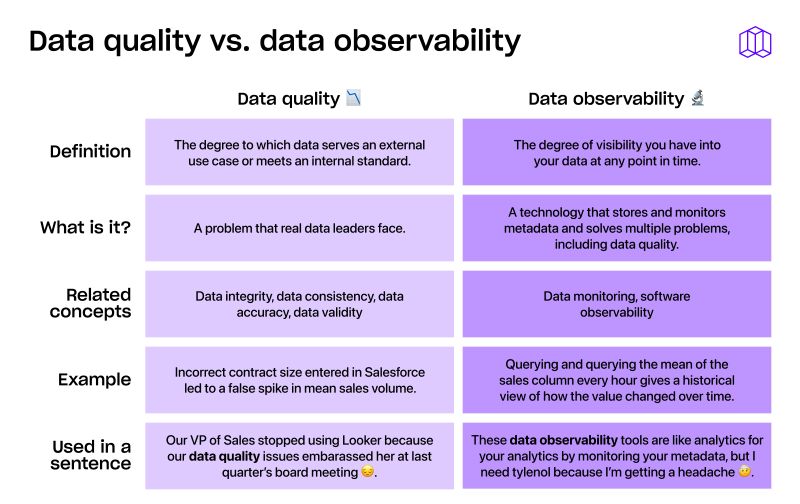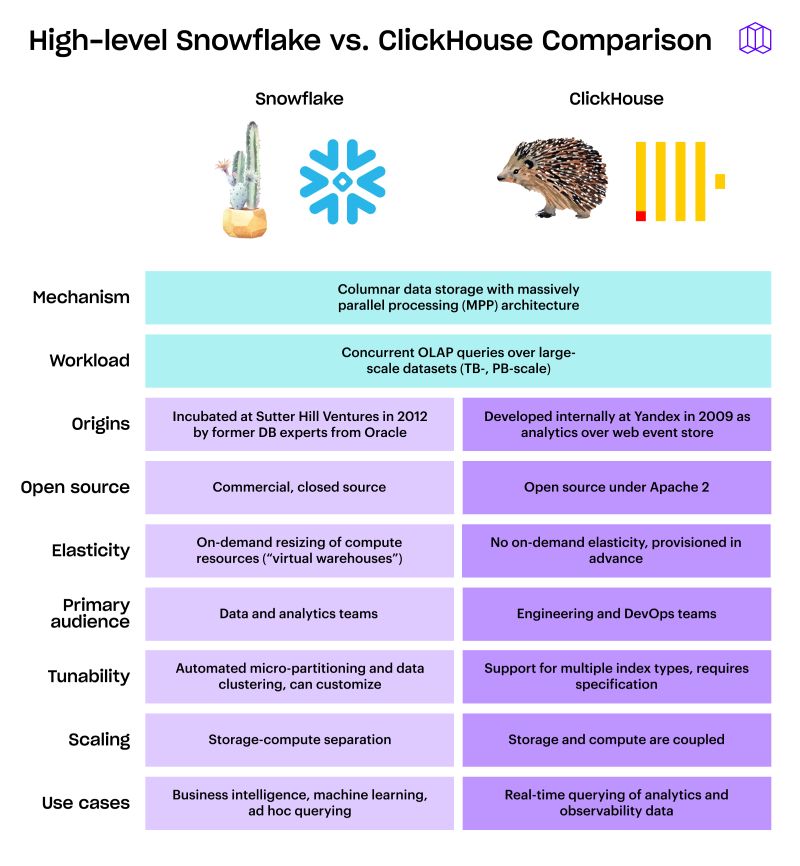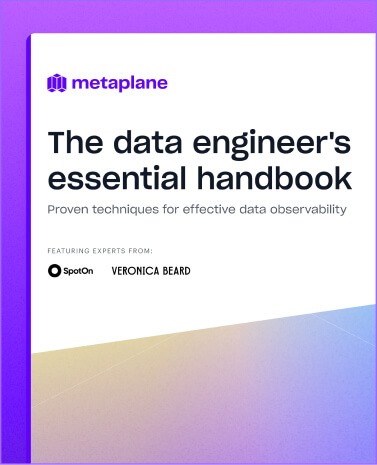How to improve data quality: 8 steps and best practices
When setting out to improve data quality, some teams think perfect data has to be the endpoint. And while there's always more you can do, it's up to you to find the right amount of checks and monitoring for what your team needs. Discover eight things your team can do right now to improve data quality.

I used to be way too overzealous with how I managed my email inbox. I created an elaborate system of folders in an attempt to organize the chaos. "Newsletter," "Action Items," "Follow Up," "Save for Later," "Urgent," "Not Urgent But Important".
After a while, though, I started crumbling under the weight of the system that was supposed to make my life easier. Eventually, the complexity of my made-up system led me to abandon it altogether and go back to no system at all.
Data teams tend to view data quality in the same binary way—implementing dozens of rules, checks, and procedures, only to find their teams bypassing these measures entirely or, worse, losing faith in the data governance process. Just as my email system would have been much more effective with a few well-chosen folders and clear workflows, successful data quality initiatives thrive on simplicity and focus.
Below, we’ll look at eight battle-tested steps to help you build more reliable data pipelines and spend less time fielding urgent messages about broken dashboards. We’ll also break down the benefits of improving data quality—and what causes it.
8 steps and practices to improve data quality
How can you avoid common pitfalls and improve the quality of your data? Here are eight steps and best practices to help you get started:
1. Enforce data entry standards
Data quality begins at the source—before a single byte enters your pipeline. Start by establishing clear, comprehensive data quality standards at every entry point, from API endpoints and form submissions to batch uploads.
One of the first steps should be creating a data validation checklist for your critical data sources, backed by thorough technical documentation that defines everything from basic formats to complex business rules. This documentation becomes your roadmap for implementation, troubleshooting, and training.
Consider implementing automated validation checks at your data entry points to enforce these standards programmatically. These checks can range from simple type validation to complex business logic that ensures data consistency across different systems. The goal is to catch and correct data quality issues at the source, preventing bad data from propagating through your systems and misinforming downstream analyses.
2. Eliminate data silos
Data silos are organizational barriers that are inconsistent, waste resources through duplicate efforts, and create competing versions of the truth. Map out your existing data sources and conduct an in-depth data inventory across departments—from official databases to spreadsheets and third-party tools—paying special attention to overlapping datasets that create confusion and inconsistency.
The goal is to create a unified, well-documented source of truth for your key business metrics, with clear ownership, governance protocols, and flexible systems that can evolve with your organization's needs.
This means building bridges between departments by creating standardized processes for data sharing and access, ensuring everyone works from the same validated dataset. This reduces or eliminates the confusion and inconsistency that data silos can create.
3. Implement data validation and cleansing
Don't wait until data reaches your warehouse to validate it: Implement basic validation checks across your pipeline, such as:
- Verifying data types
- Checking for null values
- Establishing acceptable value ranges for each field
These checks serve as your first line of defense against data quality issues. For example, if you're dealing with sales data, make sure dates fall within reasonable ranges, prices don't contain negative values, and customer IDs match your expected format.
Start with the fundamentals, then layer in your more sophisticated validation rules that reflect your business logic. This approach should include clear processes for handling exceptions, automated cleansing routines for common issues, and regular maintenance of the validation framework itself. As your business evolves, these rules and processes should be regularly reviewed and updated to remain effective and aligned with your current needs.
4. Data quality profiling
Think of data profiling as your early warning system. Just like you'd notice if your server CPU suddenly spiked, you need to know when your data patterns change. By regularly checking things like row counts and null rates, you'll catch weird data behavior before it turns into a 3 a.m. alert.
Get started with data profiling by picking your top five most critical tables and start tracking their vital signs weekly. Look for basic but telling metrics: Are row counts suddenly dropping? Are null values creeping up in required fields? Is that distribution of values looking suspiciously different from last week?
5. Conduct regular data audits
Regular data audits help you identify and address issues before they impact critical business operations. Begin by establishing a monthly audit schedule for your top five most critical datasets, examining three main dimensions:
- Accuracy (is the data correct?)
- Completeness (is any data missing?)
- Consistency (does the data align across systems?)
For each audit, create detailed checklists that compare data against source systems, validate calculated fields, and verify business rules are being applied correctly.
Build cross-functional partnerships for these audits, bringing together technical and business teams who can provide different perspectives on data quality. Track findings in a centralized repository to identify patterns over time, measure the effectiveness of data quality initiatives, and prioritize improvements. When issues are discovered, establish clear ownership and timelines for resolution, allowing findings to be communicated to all stakeholders who rely on the impacted data.
6. Establish data quality review processes
Data quality isn't just the responsibility of your data team—it takes company-wide adoption that requires systematic review processes and clear accountability at every level.
Start by implementing peer reviews for all new data transformations and scheduling regular reviews of existing ones, creating a culture where data quality checks are as routine as code reviews. Build out a review framework by establishing clear checkpoints throughout your data pipeline, with specific criteria for what constitutes acceptable data quality and who needs to sign off before data moves downstream.
Foster a culture where questioning data quality is encouraged and celebrated by creating safe channels for raising concerns, recognizing team members who identify potential issues, and making sure quality-related feedback is treated as valuable input rather than criticism. Regular training sessions can also help team members understand what to look for during reviews and how their role contributes to overall data quality.
7. Implement data governance
Data governance brings clarity and accountability to your entire data ecosystem. Create a comprehensive data ownership matrix for your critical datasets, clearly identifying who owns, maintains, and uses each data asset. Then, establish a formal governance framework that defines roles, responsibilities, and decision-making processes around data quality, including appointed data stewards who oversee specific domains and clear escalation paths for data issues.
Build data quality metrics into your governance framework by establishing KPIs that track the health of your data assets over time, from accuracy rates to resolution times for quality issues. Create clear channels for discussing data quality issues, sharing best practices, and updating policies as your organization's needs evolve.
8. Automate data observability
Data ecosystems are too complex for manual monitoring alone. Implementing automated data observability can help maintain data quality at scale, allowing you to detect and respond to issues before they impact your business operations.
Start by setting up automated monitoring for metrics across your critical datasets, such as tracking data freshness, volume fluctuations, and schema changes. Advanced data observability platforms leverage machine learning algorithms to establish baseline patterns and automatically detect anomalies in your data, identifying subtle shifts in data quality that might escape human notice.
Create an observability strategy that goes beyond simple metrics by monitoring data lineage, tracking performance metrics, and implementing end-to-end testing to validate data transformations. Build dashboards that provide real-time visibility into your data health, and regularly review and adjust your monitoring parameters based on false positives, missed issues, and changing business requirements.
Be sure to document your monitoring setup thoroughly by including what metrics you track, why they matter, and how to interpret different types of alerts. This helps maintain a level of consistency in how you handle data quality problems.
Benefits of improving data quality
Why does investing in data quality matter?:
- Faster decision-making: When data is reliable, teams can immediately act on insights rather than spending hours double-checking numbers. Instead of three stakeholders independently checking the same dashboard for accuracy, one can own that responsibility while the others focus on what the numbers mean for the business.
- Less firefighting: Better data management means fewer late-night emergencies and more time for meaningful work. When your team isn't constantly troubleshooting discrepancies in your data, they can focus on more important tasks.
- Lower operational costs: Finding and fixing bad data issues early is like preventive maintenance—it's far more cost effective than dealing with a system-wide problem later. A simple validation check that catches corrupted data during ingestion might take an hour to implement, but it can prevent weeks of rework down the line and help teams avoid making costly business decisions based on flawed data.
- Greater trust: When stakeholders consistently get accurate data, they're more likely to use data-driven insights for decision-making—something that 80% of leaders would reportedly prefer. This creates a culture with increased trust that aligns with greater data adoption across the organization, ultimately driving better business outcomes.
These benefits compound over time. As your data quality fundamentals improve, teams spend less time on data cleansing and questioning the numbers and more time using them. Data engineers can focus on building new features instead of troubleshooting issues, analysts can deliver insights faster, and business teams can make decisions with confidence. It's a cycle that transforms data from a liability into a competitive advantage.
Causes of data quality issues
Data quality issues don't just affect individual records. Your data lineage flows through your entire data ecosystem, potentially compromising every downstream decision made using that data. Here are some of the primary causes behind data quality issues:

Input errors
Whether it's from human error, misunderstandings, or system glitches, bad data at the source corrupts everything downstream. Something as simple as a financial analyst entering dates in `MM/DD/YYYY` format while the system expects `DD/MM/YYYY` can scramble an entire quarter's worth of reporting.
Even with high-quality data pipelines, these seemingly minor input errors can cascade through your system, creating problems that become increasingly difficult to trace and fix.
Infrastructure failures
When critical data pipelines fail or experience sync delays, the impact reverberates through your entire data infrastructure. Imagine your ETL process timing out during the nightly load of transaction data—downstream dashboards show incorrect daily revenues, automated alerts misfire, and business teams make more informed decisions on stale data.
Without proper failover systems and monitoring, these infrastructure issues can create permanent gaps in your historical data that are impossible to recover.
Incorrect transformations
Silent but deadly, transformation errors occur when code doesn't perform as expected, whether from unexpected data patterns or changes in business assumptions.
A transformation that calculates monthly recurring revenue might suddenly break when a new annual billing option is introduced, producing plausible-looking numbers that are actually way off. These subtle errors can poison your data pipeline, leading to misreported financials, skewed forecasts, and eventually, a complete breakdown of trust in your reports.
Invalid assumptions
Changes in upstream dependencies concerning structure, content, or semantics can invalidate previously correct assumptions in your data pipeline. When foundational elements change—like a third-party API suddenly returning nulls instead of empty strings for missing values—downstream processes built on outdated assumptions begin to fail.
These silent failures can persist for weeks, corrupting aggregations and data analytics until someone finally notices that monthly reports don't match up with expectations.
Ontological misalignment
At its core, this common issue stems from different teams speaking different languages about the same data. The data science team might define customer churn based on a sophisticated prediction model, while the finance team uses a simpler 30-day activity window, leading to dramatically different churn rates in company reports.
This misalignment is both a technical problem and a fundamental breakdown in organizational communication that leads to conflicting analytics and reduced trust in your metrics.
Streamline data quality improvement with Metaplane
Implementing these initiatives manually takes time and resources you probably don't have. That's where automated data observability comes in.
Metaplane offers a powerful data quality management solution that automates key tasks and empowers teams to proactively monitor and improve their data. With Metaplane, you can easily implement the best practices we've outlined above, ensuring consistent data quality across your organization in real time. Metaplane helps you:
- Detect data quality issues before they reach your stakeholders.
- Track data quality metrics automatically.
- Get alerted when data behaves unexpectedly.
- Trace issues to their root cause quickly.
Sign up for a free Metaplane trial and see how automated data observability can help you build trust in your data.
Table of contents
Tags
...

...



















